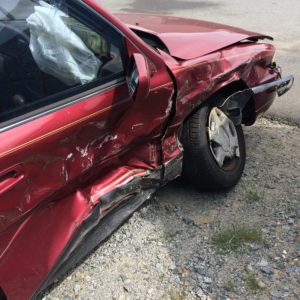Emotional
When you get into a car accident in New Jersey, many emotions run through your mind. If you’re involved in a seemingly minor fender bender, you may start off with a feeling of relief. That is, until later when you realize you’ve suffered serious injuries and need medical treatment. Contact the Law Offices of Anthony Carbone today to help you with your case.
Many people injured in car crashes react differently as far as inconvenience or devastation. Don’t think you’re unusual if you feel overcome by anger, confusion, anxiousness, or frustration. The results of a motor vehicle collision may infiltrate your daily thoughts. In some cases, you may replay the accident in your head as you try to drift off to sleep.
Reported Crashes

The New Jersey Department of Transportation (DOT) maintains records concerning reported car crashes. If you were involved in a motor vehicle collision, you join many others.
In 2018, New Jersey state authorities tallied 278,413 reports of crashes throughout the state. The numbers exclude incidents that occurred on private property. Additionally, some automobile accidents go unreported.
Car Cost
In best-case scenarios, little to no property damages surface as the only issue. Without question, repairing a vehicle costs money. You’re shocked to learn that you need to make a claim with your own insurance company even when the accident isn’t your fault. Of course, you’ll again feel anger and frustration when you learn you need to come up with the deductible.
Why is that, you wonder? New Jersey has a “no-fault” policy when it comes to auto accidents. The procedure for making a claim strikes you as confusing and unfair. If getting your car fixed alone is going to cause so much trouble, what happens if you suffer injuries?
For a moment, return to the numbers collected by the NJ DOT. Year after year, thousands of people complain of injuries at the time of the crash. Many more don’t discover they’re hurt until a few days later.
Motor Vehicle Accidents and Medical Bills
Medical treatment then becomes a primary concern when you suffer injuries in a motor vehicle accident. You already know how confusing it is to make a claim for property damage. Now, your focus turns to make sure you have insurance coverage for your medical bills. Not all car crash victims have their own automobile insurance policies. If you own and operate a vehicle in the State of New Jersey, you face legal requirements regarding coverage.
In most cases, payment for your medical treatment falls under a portion of your coverage known as Personal Injury Protection (PIP). Depending on the extent of your policy limits, you may have adequate coverage to ensure payment of your medical bills. There’s also the chance that your health benefits will cover your costs.
 Then, there is the possibility that you may not even own or operate a vehicle in New Jersey. You could be a passenger in someone else’s car. Auto-pedestrian accidents also cause significant harm. Additionally, when an automobile crashes into someone on a bicycle, the results often manifest as catastrophic injuries.
Then, there is the possibility that you may not even own or operate a vehicle in New Jersey. You could be a passenger in someone else’s car. Auto-pedestrian accidents also cause significant harm. Additionally, when an automobile crashes into someone on a bicycle, the results often manifest as catastrophic injuries.
On the Job
Notably, some car crashes involve work-related claims. For example, if your employer sent you on an errand, you might be entitled to workers’ compensation benefits. In such cases, your employer’s insurance company provides you the names of specific treating doctors. For on-the-job injuries, the only exception for authorized medical care concerns emergency treatment.
An experienced motor vehicle accident attorney helps injury victims through the claims process. When you’re hurt, it’s difficult to understand how the whole system works. It’s particularly frustrating when you had absolutely nothing to do with the accident.
Do your best to limit your conversations with your own insurance company, as well as the representative from the other carrier. When you are requested to give written or oral statements, you should refer insurance adjusters to your attorney.
Economic Damages
A recent New Jersey Supreme Court ruling resulted in a change in the way car accident victims can handle the claims process. Previously, injury victims who selected the limitation on lawsuit option as part of their policy could not sue for economic damages.
However, if your bills exceed the amount of PIP benefits available to you, your attorney can discuss pursuing a lawsuit for them. All in all, you should not sustain severe economic losses when you are injured by no fault of your own.
Time Limitations for Automobile Accident Negligence Claims
It may seem like a complicated process to pursue compensation from someone else if you’ve been injured in an automobile accident. Once again, an experienced personal injury attorney can help guide you through the process.
You should first know that there are time limitations when it comes to filing negligence claims regarding car crashes. As soon as you discover you suffered injuries, you should meet with an experienced automobile accident attorney to discuss your options.
car crashes. As soon as you discover you suffered injuries, you should meet with an experienced automobile accident attorney to discuss your options.
When to File a Lawsuit or Claim
You may be under the impression that you have two years from the date of the accident in which to file a lawsuit. Assuredly, that represents the truth in many cases. However, there are exceptions to the rule:
- For example, a claim against the Port Authority of New Jersey and New York comes with even stricter time limitations; in order to pursue a negligence claim against the Port Authority, a lawsuit must be filed within one year.
- Another example, if a government employee runs a red light and rams into your vehicle, the law requires you to follow specified notification requirements. More than likely, you’ll need to file a Notice of Claim within 90 days of the occurrence. In special cases, the court may grant you an extended notification time period. In some cases, the statute of limitations may be even more expansive than expected.
An experienced personal injury attorney can help you when it comes to matters involving children or on-the-job injuries. For the most part, the same time limitations apply when you lose a loved one in a fatal automobile accident. You should not procrastinate in your pursuit of a claim for damages.
Other Considerations Involving Car Crashes and Compensation
Under New Jersey law, automobile insurance policyholders have a few options when it comes to car crashes and compensation. In order to restrict costs, many vehicle owners limit their right to sue for damages.
One of the major differences between policy choices concerns the right to sue an at-fault driver for pain and suffering. Even so, there are several reasons you can pursue a lawsuit with a lesser option. An experienced automobile accident attorney can review the feasibility of pursuing a claim for money damages.
You should also know that you may be entitled to sue a negligent party for aggravation of pre-existing injuries. For example, you may have healed from a previous knee or hip replacement. The force of a car crash could easily change your circumstances and quality of life.
 Wrongful Death
Wrongful Death
If you’ve lost a loved one due to a motor vehicle accident, your lawyer can also explain the procedures associated with a wrongful death claim. To begin, you’ll need to determine who has the right to pursue legal action on behalf of the estate.
Hurt at Work
What about if you were hurt at work while involved in a motor vehicle accident? First, you won’t have to prove someone else was at fault to make a claim. Secondly, you may be able to pursue a third-party case against the individual who caused the crash.
Here’s something else for consideration. Were you partially at fault for the collision that resulted in your injuries? As long as you were less than 50% negligent, you may be entitled to compensation.
New Jersey car accident lawyer Anthony Carbone understands how upsetting and confusing it is after an auto accident, especially if it took the life of someone you loved. Many insurance companies and individuals will fight against paying what is your rightful compensation. It’s not that insurance adjusters necessarily doubt you’ve suffered as a result of an accident. However, carriers are in the business of making money. If they afford your payments of any kind, they lose.
Closure
Another thing to keep in mind:
- Insurance fraud represents a punishable offense.
- Don’t makeup or exaggerate injuries and expect you’ll escape prosecution.
- Medical experts may point out their suspicions.
- And, if the facts don’t add up, you could find yourself in big trouble.
In the meantime, you should know that Attorney Carbone wants to help you gain compensation and closure from your auto accident and allow you to start living your life normally again. A combination of over three decades of experience and advocacy proves critical when pursuing a case on your behalf. While money can’t bring you back to your condition before the accident, it can help you move forward.
Our motor vehicle accident lawyer in New Jersey can answer your questions about New Jersey law concerning auto accident litigation. Many cases never make it to the courtroom. Attorney Carbone’s experience helps in achieving settlement awards without the expense of a trial. With all this said, you need to know what to do if you’re involved in a car crash. Learn what your first steps should be after a motor vehicle accident.
Car Accidents in New Jersey: Frequently Asked Questions (FAQs)
Do You Have to Report a Motor Vehicle Collision to the Police in New Jersey?
All significant motor vehicle collisions should be reported to law enforcement in New Jersey. Under state law, a crash should be reported to the police if it resulted in an injury, a fatality, or more than $500 in property damage. As a general rule, it is a best practice to report a serious collision to the police immediately. An officer (or multiple officers) will be dispatched to help control the scene. The responding officer will also write an official crash report. The police report can serve as an important form of evidence in an auto accident claim.
How Do I Get a Copy of the Police Report After a Car Crash in New Jersey?
You should get a copy of the police report directly from the department that handled your crash. If you were hurt in an accident in New Jersey, the crash may have been dealt with by the New Jersey Police Department. As of 2022, this department still lacks an online car accident report request system. You can call the New Jersey Police Department via phone at (201) 547-5321 and get a crash report via fax, mail, or in-person. If the New Jersey State Police handled your accident, you can use their Crash Report Requests On-Line tool to make a request.
Is New Jersey a No-Fault Car Accident State?
Yes—at least it is for minor and moderate collisions. Most motorists in New Jersey have some form of no-fault Personal Injury Protection (PIP) coverage. Following a minor or moderate crash, it is your PIP policy that will be responsible for handling your claim. Fault is not a factor in these cases. Though, if you have no-fault coverage, you can still step outside that coverage after a serious crash.
It is also important to emphasize that New Jersey is one of very few U.S. states that offers motorists a choice regarding no-fault insurance coverage. Some policyholders are effectively “opted out” of New Jersey’s no-fault system. If you have any questions about fault and no-fault insurance coverage in New Jersey, our New Jersey car crash attorney is available to help.
What Constitutes a “Serious” Injury Under New Jersey’s Auto Accident Law?
In New Jersey, you can always file a personal injury lawsuit directly against an at-fault party if you suffered a serious injury in a crash. This is known as the state’s serious injury threshold—and if you meet it, you have the right to step outside of the no-fault system regardless of what type of insurance coverage you have. Here are the six categories of serious injuries in New Jersey:
- Dismemberment;
- Significant disfigurement;
- Significant scarring;
- Displaced fractures;
- Loss of a fetus; and
- Permanent Injury.
What If I Am Found Partially At-Fault for My Own Serious Accident?
You can still file a personal injury lawsuit after a serious accident in New Jersey even if you were partially to blame for the crash. Under New Jersey law (N.J.S.A. § 2A:15-5.1), these cases fall under the state’s modified comparative negligence standard. As long as you were not at fault for the majority of the accident (51 percent), you can still recover compensation through a legal claim. Your compensation will be reduced in relation to your amount of fault. For example, if you were 30 percent at fault for a serious accident in New Jersey, you can be held liable for 30 percent of your own damages.
Should I Give a Recorded Statement to an Insurer After a Major Crash?
No. You should avoid giving a recorded statement directly to an insurance adjuster after a serious crash. This is true whether you are dealing with your own insurer or another party’s insurance company. Before agreeing to give a recorded statement, it is imperative that you consult with an experienced New Jersey auto accident attorney. Your attorney will protect your best interests.
Can I Afford to Retain a Top New Jersey Auto Accident Lawyer?
Yes. Everyone should have access to a reliable, experienced auto accident attorney. At The Law Offices of Anthony Carbone, our New Jersey car accident lawyer represents injured victims on a contingency fee basis. Regulated under New Jersey Court Rules (Rule 1:21-7 C), a contingency fee arrangement is an agreement under which an attorney gets paid as a percentage of the ultimate settlement or verdict. In effect, this means that you do not have to pay upfront costs or out-of-pocket fees. Our New Jersey auto accident attorney only gets paid when you get compensation.
Different Types of Auto Accidents
There are many types of auto accidents that our law firm handles, such as:
- Car Accidents
- Truck Accidents
- Bus Accidents
- Motorcycle Accidents
- Bicycle Accidents
- Pedestrian Accidents
- Utility Truck Accidents
- Mass Transit Accidents
- Taxi Accidents
- Jitney Bus Accidents
- Weather-Related Accidents
- Aggressive Driving/Speeding Accidents
- Drunk Driving Accidents
- Drowsy Driving
- Hit and Run Auto Accidents
- Fatal Auto Accidents
- Distracted Driving
- Auto Accidents with Uninsured Motorists
- Multi-Vehicle Accidents
- Ridesharing Accidents
- Turo Car Accident Attorney



